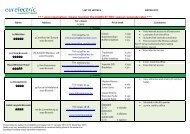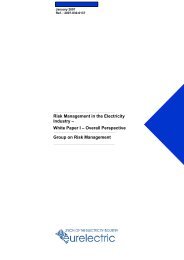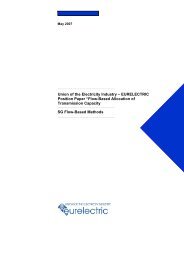Hydro in Europe: Powering Renewables - Full Report - Eurelectric
Hydro in Europe: Powering Renewables - Full Report - Eurelectric
Hydro in Europe: Powering Renewables - Full Report - Eurelectric
Create successful ePaper yourself
Turn your PDF publications into a flip-book with our unique Google optimized e-Paper software.
plants are designed to use either a large flow rate with small head on large rivers with<br />
gentle gradient, or a small flow rate with high head <strong>in</strong> mounta<strong>in</strong> areas. Pictures 1 and 2<br />
show a low head run-of-river power plant and a high head run-of-river power plant <strong>in</strong><br />
northern Norway, respectively.<br />
Picture 1 Freudenau run-of-river power plant <strong>in</strong> Austria<br />
(a low head run-of-river power plant)<br />
Source: Verbund<br />
25<br />
Picture 2 Nore power station – a high head run-ofriver<br />
plant <strong>in</strong> Norway<br />
Source: IEA<br />
Electricity output of run-of-river power plants depends on the availability of water <strong>in</strong><br />
the river and varies considerably throughout the year. Seasons, ra<strong>in</strong>fall or snowmelt all<br />
<strong>in</strong>fluence the amount of water available for electricity generation. Because they lack<br />
storage, run-of-river power plants operate under the constra<strong>in</strong>t of precisely controll<strong>in</strong>g<br />
the water level at the <strong>in</strong>take <strong>in</strong> accordance with <strong>in</strong>com<strong>in</strong>g river flow. Run-of-river<br />
hydropower plants without connection to upstream storage typically operate as baseload<br />
power plants s<strong>in</strong>ce the hydrological forecast is sufficiently good for the timescales<br />
required <strong>in</strong> the electricity market.<br />
Services<br />
Run-of-river hydro plants have little or no storage capacity. Therefore they offer only<br />
very short-term storage possibilities (few m<strong>in</strong>utes dynamic cycle), thus allow<strong>in</strong>g for<br />
some adaptation to demand, especially for ancillary services such as frequency and<br />
voltage control.<br />
Cascad<strong>in</strong>g hydropower schemes – a well orchestrated system<br />
Other, upstream hydropower plants or reservoirs have to be taken <strong>in</strong>to consideration<br />
when look<strong>in</strong>g at the energy output of a run-of-river plant. A constant output from a<br />
run-of-river hydropower plant is possible if the river is already regulated further<br />
upstream by a hydropower plant with storage capacity (thanks to the reservoir). A<br />
commonly used strategy to optimise the energy output of hydropower plants on a<br />
river is to build a large storage reservoir <strong>in</strong> the upper catchment which will even out<br />
flows for several run-of-river or smaller reservoir plants downstream, as illustrated <strong>in</strong><br />
Figure 12. Figures under each plant <strong>in</strong>dicate how high from the sea level they are<br />
located.

















